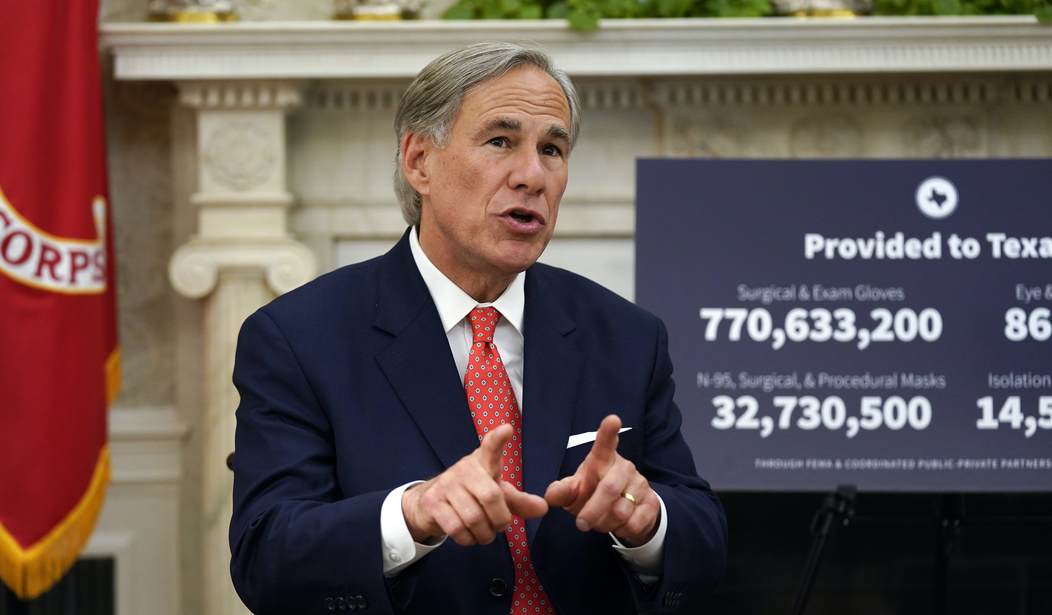It’s been a month and a half since Texas Governor Gregg Abbott gave the left heart palpitations by eliminating the state’s mask mandate and most other virus restrictions.
So, according to liberals, there must be dead bodies in the streets and jam-packed hospitals full of sick and dying patients in Texas, right?
President Joe Biden said the governor’s decision reflected “Neanderthal thinking.” Gilberto Hinojosa, chairman of the Texas Democratic Party, said it was “extraordinarily dangerous” and “will kill Texans.” The national media ridiculed Abbott and Texas as a bunch of rubes who deserved whatever they got.
Meanwhile, new cases of COVID-19 have dropped substantially and deaths have fallen as well.
Yet a month and a half later, newly identified coronavirus cases in Texas have fallen by more than 50 percent, and daily deaths have dropped even more.
Meanwhile, states with stricter COVID-19 regulations have seen spikes in daily new cases. This is not the pattern you would expect to see if government-imposed restrictions played a crucial role in curtailing the pandemic, as advocates of those policies assume.
The key, according to Jacob Sullum, is that Texas was already partially open when Abbott lifted the mask mandate.
Most businesses in Texas had been allowed to operate at 75 percent of capacity since mid-October, when Abbott also allowed bars to reopen. It was implausible that removing the cap would have much of an impact on virus transmission, even in businesses that were frequently hitting the 75 percent limit.
While Abbott said Texans would no longer be legally required to cover their faces in public, he urged them to keep doing so, and many businesses continued to require masks. At the stores I visit in Dallas, there has been no noticeable change in policy or in customer compliance.
Some states that removed their mask mandates, like Florida, are seeing spikes in infections. But Florida’s death rate is smaller than California’s, leading to the obvious question: Have all the restrictions helped or hurt?
While some researchers have concluded that lockdowns had an important impact, others say there is little or no evidence that they affected mortality rates or trends in cases. According to a Nature Human Behaviour study of 226 countries published in November, “a suitable combination of NPIs [nonpharmaceutical interventions] is necessary to curb the spread of the virus,” but “less disruptive and costly NPIs can be as effective as more intrusive, drastic ones (for example, a national lockdown).”
In a 2020 National Bureau of Economic Research paper, UCLA economist Andrew Atkeson and two other researchers looked at COVID-19 trends in 23 countries and 25 U.S. states that had seen more than 1,000 deaths from the disease by late July. After finding little evidence that variations in public policy explained the course of the epidemic in different places, they concluded that the role of legal restrictions “is likely overstated.”
Perhaps “oversold” is a better term for all the mandates lasting as long as they did. But getting the national media to recognize that the mandates and restrictions may not have been necessary for as long as they lasted is still a challenge.
“The Washington Post nevertheless says ‘experts…agree’ that rising infection numbers are largely due to ‘a broad loosening of public health measures, such as mask mandates and limits on indoor dining’—a claim that is tenable only if you ignore all the countervailing examples.”
It isn’t so much that mandates and restrictions didn’t serve a purpose. What Abbott and Texas showed is that when that purpose is no longer necessary, it can be safely jettisoned.










Join the conversation as a VIP Member